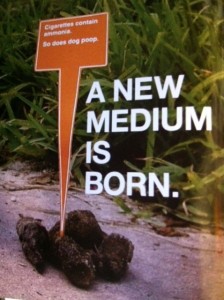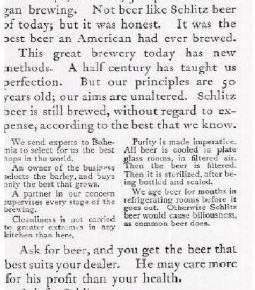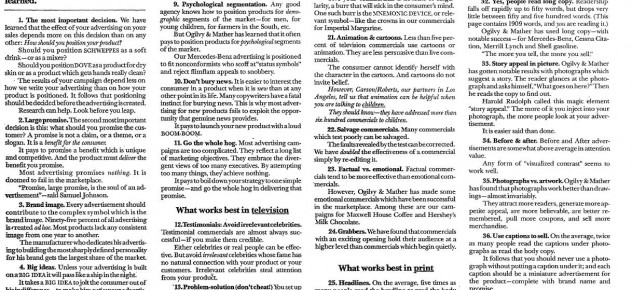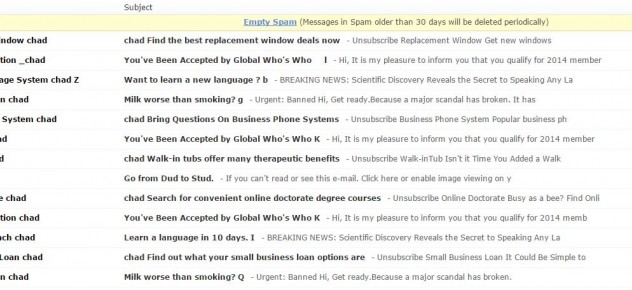38 Writing Tips from David Ogilvy That Still Sell Today (Part 1 of 2)
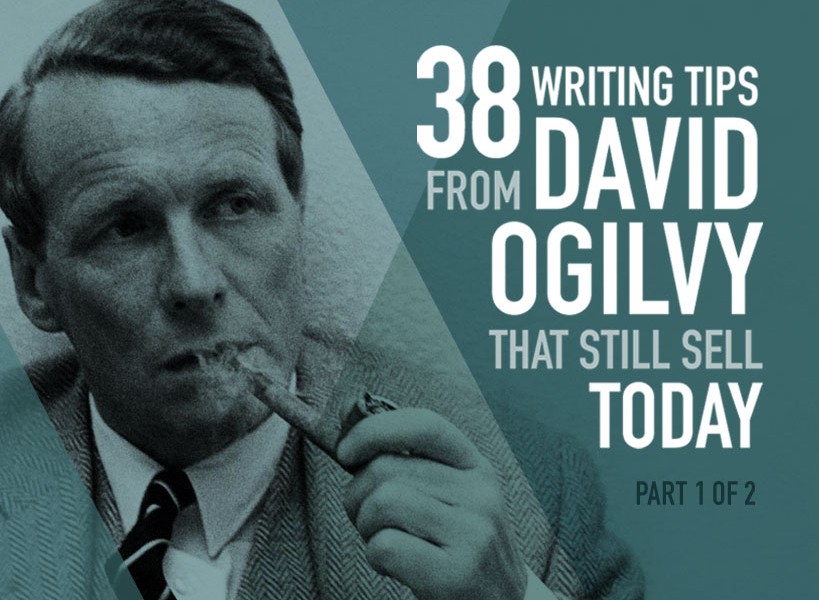
If you want to improve your writing—your headlines, landing pages, apps, presentations and opt-ins—and you want to improve your sales—online and off—then heed David Ogilvy’s advice.
He’s been called the Father of Advertising. And the King of Madison Avenue. And to this day, his name creates coffee shop slap-fights between right-brained and left-brained advertising practitioners.
I’ve compiled 38 writing tips from David Ogilvy that still sell today, then broken down each one with case studies and life lessons from my 15+ years in the ad business.
HOUSEKEEPING: Dear Millennials, if you can’t read 10,300 words in one sitting and, honestly, I don’t blame you, fret not.
Why 38 writing tips?
1. It follows in the footsteps of Ogilvy’s famous ad, “How to Create Advertising that Sells,” which offered 38 tips.
2. Ogilvy was 38 years old when he took his first advertising copywriting job. So if you’re whining about being too old to improve your copywriting—or to start a career in writing—think again and keep reading.
Tip #1: Give the facts.
According to Ogilvy, facts were more important than adjectives. He is clear on this. When he speaks to a consumer, he gives the “the facts, facts, facts.” His proof was Rolls Royce and Mercedes. If you have a fact, he says, don’t bury the lead. But here’s the trick, in my opinion: finding facts that matter to your consumers. You don’t care that a Rolls Royce goes 60 miles an hour. Big whup. But hey, if the loudest noise you hear at 60 miles per hour is the electric clock, then wow, that’s unexpected. I’m listening. 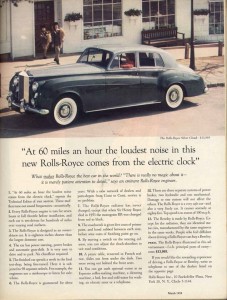 No one trusts advertising today, so you need more than facts. You need an unexpected presentation of your facts to grabs a reader’s attention. One of the greatest, most effective campaigns of my generation is based on facts: Truth.
No one trusts advertising today, so you need more than facts. You need an unexpected presentation of your facts to grabs a reader’s attention. One of the greatest, most effective campaigns of my generation is based on facts: Truth. 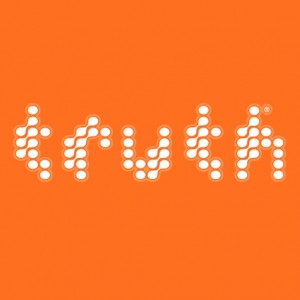 The genius behind the Truth Campaign was that the creative and strategy teams didn’t simply push the death toll facts about tobacco. Their target audience had a 100% awareness that tobacco kills. Arnold Worldwide & Crispin Porter Bogusky couldn’t simply drop death numbers. Instead, they told the truth about cigarette ingredients, as well as (and more importantly) the manipulation facts that tobacco conglomerates used to trick youth. No one likes being swindled, especially youth.
The genius behind the Truth Campaign was that the creative and strategy teams didn’t simply push the death toll facts about tobacco. Their target audience had a 100% awareness that tobacco kills. Arnold Worldwide & Crispin Porter Bogusky couldn’t simply drop death numbers. Instead, they told the truth about cigarette ingredients, as well as (and more importantly) the manipulation facts that tobacco conglomerates used to trick youth. No one likes being swindled, especially youth.
A final thought on facts: facts are a must in the B2B realm. ROI rules; fluff and generalities fill landfills.
Proof: 9% of B2B consumers considered vendor content trustworthy vs. 67% who trust research from professional associations.1
2. Quantity begets quality.
Begets. That’s a great word rarely used, except for 75% of the Book of Leviticus. My best headlines have yet to be written in 10 minutes. Now, that would be ideal. Not very billable, but ideal. I’m no savant, and neither was Ogilvy. Far from it. Check out these stats:
-
-
- His Rolls Royce ad required 26 headlines and 6 different writers.2
-
-
-
- A Sears Roebuck ad took him 37 headlines.2
-
-
-
- A Puerto Rico ad took him 10 days to write (10 days!).3
-
-
-
- He wrote fewer than 16 headlines for a single advertisement.4
-
The horse’s mouth: “I’ve done as many as 19 drafts of a single piece of copy. I wrote 37 headlines for Sears Roebuck last week and I think I got three good enough to submit.”2 Writing 37 headlines is a drag, but I challenge you to write a great line and then spend one hour trying like hell to beat it. Don’t barely beat it. Destroy it. Belittle it. Make it cry, “uncle!” I know you can. This tip can get tricky when it comes to freelance copywriting, because you don’t want to bill two hours for one headline. Here’s a freelance copywriting trick I learned: always send them at least five headline options. If you’re writing a brochure, every single headline deserves the love of three solid lines. And be sure to save your dead ones. Why? Because inevitably, your client will complain about paying “so much money for just a few lines.” That’s when you pull out the 59 lines you killed and show it to them. Craftsmanship!
3. Headlines are god.
We have established the importance of quantity, and how it begets quality in your writing. This importance of quantity and quality is ramped up tremendously in a headline. Yes, even a subject line: 1/3 of all emails are opened based on subject lines.5 Ogilvy said that if your headline didn’t sell the product, your client “wasted 90% of their money.”3 It’s that important. A headline is not your handshake with the prospect; it’s the eye contact before the handshake. It’s the first thing they see. Do they see help? Do they see a benefit? Do they salivate at the prospect of their pain going away? Or do they get that confused dog look and tilt their head? You know what your prospects care about? Them. Not you. Not your product. Them. If you don’t communicate a unique, compelling benefit lickety-split—in your blog, on Facebook, in a print ad—it’s over. No pressure! Here’s my favorite headline of all time. It uses the power of imagination to let the motorcycle audience overcome their biggest barrier to purchase: procrastination. “What are you waiting for?” it screams, but in a classy way. 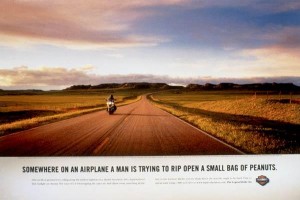 P.S. If you want to start crafting headlines right-this-very-minute, I suggest you check out Quick Sprout’s brilliant headline-writing tutorial. They mention David Ogilvy, of course.
P.S. If you want to start crafting headlines right-this-very-minute, I suggest you check out Quick Sprout’s brilliant headline-writing tutorial. They mention David Ogilvy, of course.
4. Write for an audience of one.
The most successful advertising is a communication between one human being and another. Ogilvy described it as sitting across the table from the consumer, having dinner. He used this dinner metaphor repeatedly in his books and many of his agency’s ads. Dude was obsessed with dinner. But his metaphor is apt. Try and make your story as interesting and fascinating as possible. And make it personal. If it’s boring to you, it’s boring to them. This is the genesis of Google Penguin 2.0, at least on paper. If the user wants it, and you offer it, then all is well. If not, then Larry Page will come a’ knockin’.
Ogilvy explains, “I have a theory that the best ads come from personal experience.”2
I had an executive creative director who started every big presentation with a personal story about himself and the product. Did he make them up? Maybe. I’m sure he ever stepped foot inside a Bojangles, for example, for a Cajun Filet Biscuit. Did the clients love hearing a personal story from the heart, as opposed to stats and figures and pie charts? You bet they did. [Tweet “Everyone loves a great story, especially when it’s about them.”] Remember, you are solving a person’s problem. Know the problem, talk about the problem and offer a solution. You’re a fixer, not a marketer. Who hasn’t been on a date that went sour by the time the appetizer arrived? If someone seems fake, they are fake. It’s amazing how the human intellect can detect B.S. I believe that evolution has exponentially ramped up our B.S. meters in the last the decade. Most likely, because of advertising. Writing Tip: Some writers create a persona for their main client’s target audience. They print this persona out, pin on the wall and stare deep into their persona’s soul. Kinda creepy, but, hey, if it helps…
5. Get to the point.
What you can say in 10 words, don’t say in 20 words. And those 10 words? What if you could say it in eight words? The most successful writers are craftsmen. They tweak and turn and twist their words around until they’re just right. Ogilvy believed that long copy outsold short copy, and he had the research to the prove it. But this really depends upon the medium. My most successful copy of all time—at least award-wise—has no copy at all. It did, at one time. But the more my art director partner and I refined the headline for an outdoor placement, we realized it wasn’t even needed.Be pithy when you have to be.  Marketing Experiments ran a test of landing page copy and found that long copy outperformed short copy by 40.54%. This makes perfect sense when you think about the average consumer’s buying process. Outdoor is for awareness. But when consumers research a product, service or company, they go online. They want answers, not a fancy image.
Marketing Experiments ran a test of landing page copy and found that long copy outperformed short copy by 40.54%. This makes perfect sense when you think about the average consumer’s buying process. Outdoor is for awareness. But when consumers research a product, service or company, they go online. They want answers, not a fancy image.
6. Copy your elders. Not literally.
My advertising hero is Gerry Graf. You may not recognize the name, but you’ve seen his work for Little Caesars, Skittles and Kayak.com. Gerry admitted to copying every move of Cliff Freeman, especially his Little Caesars TV campaign. (In a cool twist, Graf’s Barton F. Graf 9000 shop is now the agency of record for that very same client—producing brilliant, award-winning work.) One of Gerry’s most famous TV spots, the Snicker’s “Chef” ad where the football field painter accidentally spells “chef” as “chief,” Gerry admitted to stealing the final line “Great googly moogly” from Sanford & Son.7 Inspiration is everywhere. Find your mentors. See how they form their sentences. How they write long copy. How they write emails. How they sell themselves on podcasts or blogs. Follow them on Twitter and Facebook and just stalk them for a few weeks. Then, email them directly and ask for advice. Don’t be shy. Don’t be “stalky” aggressive, of course, but just ask for advice. You’ll find the majority of them will return your email. Here’s an example email, and be sure to use specifics.
Example Email: [Your god goes here], Loved your ad/tweet/podcast. It really spoke to me as an aspiring writer/entrepreneur. Particularly the part about [use specifics here]. If you have any advice for me, I would appreciate any and all nuggets. I’m having a hard time [insert your biggest issue]. Sincerely, [You]
I’ve found that the more specific your question or “ask,” the higher the response. I’ve received many undergraduate emails requesting advice on careers and, well, I don’t have three hours to decipher who you are and where you’re going. The emails with specific questions [how do I improve my headline writing] are the responses I can bang out in five or 10 minutes. Remember, your email is 1 of 1,000.
7. Don’t do crap. Sell.
I’m paraphrasing, of course. But did you know that bankers and lawyers are seen as more ethical than advertising practitioners? Seriously. Click on the chart if you dare:  I wrote a blog pleading to the practitioners of our industry to save us, but it’s going to take time. To start, you need to care. You will care during your first week on the job. You will care during new business pitches. You will care when you launch your first website or your first blog post or your first app. The key is to keep caring on your 10th app or your 422nd blog post. An example: Ogilvy was forced by his Lever Brothers client to write a crappy ad.4 He swallowed his pride, against all restraint, and wrote a jingle:
I wrote a blog pleading to the practitioners of our industry to save us, but it’s going to take time. To start, you need to care. You will care during your first week on the job. You will care during new business pitches. You will care when you launch your first website or your first blog post or your first app. The key is to keep caring on your 10th app or your 422nd blog post. An example: Ogilvy was forced by his Lever Brothers client to write a crappy ad.4 He swallowed his pride, against all restraint, and wrote a jingle:
Sung to “Boys and Girls Come Out to Play”: Rinso White or Rinso Blue? Soap or detergent—it’s up to you! Both wash whiter and brighter than new, The choice, dear lady, is up to you!
Ugh. After the ad ran, Ogilvy said he was embarrassed to show up for work. His copywriters knew it was crap. His account directors knew it was crap. HE knew it was crap. You may think to yourself, “Hey self, it’s one little Tweet. It’s late. No one will know. It’s not going to hurt anything.” Wrong. You will know. And after you’ve written one crappy Tweet, it’s easier to write two. Then three. Then you’re a hack who plays jazz music with his door closed and eats lunch alone, you hack. I’m often asked how you know something is crap. Don’t be naïve. You know when you write it, don’t you? Of course you know. Don’t do crap. Your clients deserve better.
8. A/B test. Repeat.
Did you know that Ogilvy started his advertising career in research? He worked for Dr. George Gallup at Princeton. Yes, the Gallup that invented the Gallup Poll. This is why Ogilvy approached advertising (and writing) from the point of view of a researcher. Apart from being the owner and creative director of his own agency, Ogilvy was also the research director. He spoke of wearing his “research director” hat on Friday, handing in his assignment and then walking in on Monday with this “creative director” hat. Did you notice what hat he wore first? I believe that if Ogilvy were alive today, he would A/B test every single online advertising piece and “know to the dollar” what worked and why. No questions asked. He would test and test to find a winner, and then he would run the hell out of that winner. (See Tip #29.) Why aren’t you doing A/B testing? As a writer, I think I know what headline would work best. But more often than not, I’m wrong. [Tweet “It’s not fun being wrong. But it’s not fun being broke either.”] One of Ogilvy’s favorite quotes comes from the great Rosser Reeves, who was more of a research guru than Ogilvy was. Here’s the story, told by Rosser:
Let’s say you’re a manufacturer. Your advertising isn’t working and your sales are going down. And everything depends on it. Your future depends on it, your family’s future depends on it, other people’s families depend on it. Do you want fine writing? Do you want masterpieces? Or you do you want to see the goddamned sales curve start moving up?
Want a real-life case study? Check out the famous Barack Obama email campaign from 2012. One subject line was projected to raise more than $2.1 million compared to another. Think A/B testing is for nerds? Start today and line your pockets with crisp $100 bills.
9. Write with authority.
The best writers are chameleons. I’m not a millionaire, but I’ve survived (and sometimes thrived) at five different advertising agencies and written successfully for baseball teams, tires, lift trucks, banks, hot dogs, capsules and defense armor. Sometimes, all in one day. I’m either great at faking it or I stay up late at night learning my craft and my subject matter. (I hope it’s the latter.) It helps to enjoy your subject matter, but we’re not all David Ogilvy so we can’t pick and choose Rolls Royce and Bermuda clients.
The future of advertising and marketing does not belong to the designers. It belongs to the storytellers.
To be a great storyteller, you have to know the story. You have to interview the engineer. You have to walk the manufacturing facility. You have to read the god-awful, 20-page whitepaper and wipe the tears out of your eyes because it’s so god-awful-boring-that-stupid-whitepaper-I-want-to-burn-it! Why all the pain? Because you can’t outsource knowledge. I utilize multiple freelance copywriters per week, and I won’t use writers who don’t learn the material. I can’t afford to.
Scary Statistic: In 2012, the number of B2B marketers creating all of their content in-house increased from 38% to 56%, and just 1% of B2B companies now outsource all of their content creation.6
Why are they taking it in-house? Savings is part of it, of course. But the main reason is they are experts at their clients’ products. Not some freelancer from off the street. Know your client better than they do. Or risk the very high possibility of another writer learning more than you. Don’t say David Ogilvy didn’t warn you from the grave.
10. Stay young as you grow old.
This industry is fun as hell. Even during my very worst days writing flyers for Section 179 tax savings, it’s better than 90% of most other jobs. Enjoy the brainstorming. Make fun of the idiocy. And most importantly, don’t rest on your laurels. Stay up-to-date on research. Better yet, stay up-to-date on technology. Better yet, stay up-to-date on everything. Read the trade pubs. Comment on the blogs. Devour Communication Arts. The minute I walk into a creative director’s office and he scoffs at LinkedIn as a viable advertising outlet is the day I plan my takeover. (Insert evil mastermind laugh here.) Ogilvy was famously known for having lists and sticking to them, but he was self-aware. Here’s proof:
“I’m always hoping that one day some young man will come into my office and say, ‘Your 96 rules for creating good ads are for the birds. They’re all based on research that is out of date and irrelevant. Here are 96 new rules based on new research. Throw yours out of the window.’”2
If you’re reading this and you’re new to advertising or writing, you have the power. Not the creative director. Not the marketing director. Not the account director. They’re old. They have kids and hobbies and drinking habits. Not you. Yet. You have your finger on the pulse on the future of the industry. Squeeze. Now is the time to slay the old advertising guard and take over (Metaphorically speaking. Talk to them about the new technologies and opportunities and show them a better way to build their ads or widgets. Then, write me a check to thank me. )
11. Believe in what you write.
Ogilvy was dead right when he said the best copywriting comes from “being intellectually and emotionally committed to the subject.” 5 This is easy if you write for Nike or Red Bull. This is next to impossible when you write for a trailer hitch company. I know. I’ve been there. It’s a slosh when the story doesn’t naturally “flow” from the well of your spirit. Here’s a trick: read as much as you can on the subject. You will, inevitably, find a story. A nugget. A gem in the dark mine of nothingness. Then you can, as Ogilvy said, “present complicated subjects in a way that engages the reader.”4 Right now, the agency that consistently nails this “insight” is Crispin Porter Bogusky. Pizza is pizza. It’s a commodity. However, they convinced Domino’s to admit that their product was crap. Seriously. Their entire campaign is based on the fact that their pizza was crap. 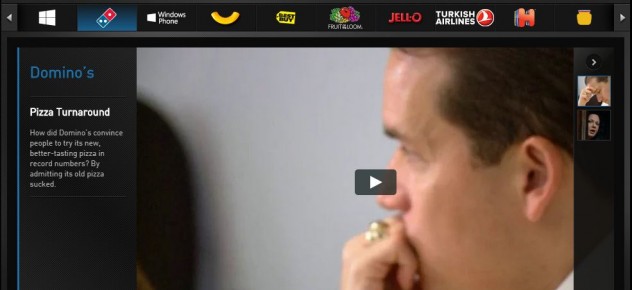 It’s quite the story, and it took guts to sell and it took guts to buy-in to the story for the franchisees. The new recipe would be impossible to implement in most franchise-owned businesses. But the franchisees believed in the brand. Why? More than 90% of Domino’s franchisees began in the business as Domino’s delivery drivers.6 Read that stat again. That is total belief in one’s product.
It’s quite the story, and it took guts to sell and it took guts to buy-in to the story for the franchisees. The new recipe would be impossible to implement in most franchise-owned businesses. But the franchisees believed in the brand. Why? More than 90% of Domino’s franchisees began in the business as Domino’s delivery drivers.6 Read that stat again. That is total belief in one’s product.
12. “Have a big idea.”
“Unless your advertising contains a big idea, it will pass like a ship in the night.” -?????? ??????
This quote is often attributed to the man responsible for the creative revolution in advertising, the great William (Bill) Bernbach. Guess what? It’s Ogilvy. He believed in the big idea and preached its power. Unfortunately, he used the “cult” word when discussing the creative revolution, so that hurts deep down. But I forgive him. Kinda. Ogilvy didn’t offer a blueprint to finding the big idea, but he hinted that it came from the unconscious…only after first being informed about the product. [Tweet “Big effort, then big idea.”] Some big ideas just appear, though they are rare. Others, more often than not, come from hustling. From doing the homework, interviewing the head engineer, interviewing the assistant to head engineer. How do you know a big idea when you see it? I have an easy way: you feel an instant pang of joy. Or if you see another big idea, an instant pang of jealousy. You wished you had thought of it. And when it comes from you, other writers and creatives whom you trust will inform you of their jealously through gritted teeth. When you write that blog that no one comments on? It’s a lonely feeling. Just listen to my 2-year-old son as he repeats Dory’s beautiful words in Finding Nemo: “Just keep swimming, just keep swimming, just keep swimming, writing, writing. What do we do? We write, write.”
13. Offer one simple promise.
Ever heard of decision paralysis? If you’ve ever looked at your 401(k) investment options, you’ve been a victim of it. Sheena Iyengar’s famous “jam” study at Columbia University enlightens us to the power of decision paralysis due to “choice overload.” In the study, 24 jams were on put on display in a supermarket. Then only six. The results: 60% of supermarket consumers stopped by the 24 jam display for a sample, versus 40%. But here’s the kicker: Only 3% of the 24 jam tasters purchased jam with a coupon…while 30% of consumers who tried the 6 jam taste test purchased with a coupon!8 Humans just can’t handle 24 choices. I know I can’t. I’d rather sit down at my desk with six projects than 24. I wouldn’t know where to start. Ogilvy asked that we not offer “the whole hog…but the whole hog on that one promise.” Yummy. The Unique Selling Proposition is not dead, no matter what you hear. Find that one big nugget and sell the hell out of it. One of my favorite bloggers and self-help gurus, James Altucher, encapsulates the brand of “helpfulness.” That’s his promise in every post and book (such as Choose Yourself, which costs a whopping 99 cents—the best deal you can find online). Here’s proof: James sent an email with his cell number to his hundreds of thousands of followers. His cell number! Now, that is living the brand. One promise. Bring it to life with passion.
14. The more you tell, the more you sell.
What?! You just told me to sell one promise, not the whole hog. Yes, but it depends upon the medium. Long form print sold more in Ogilvy’s time than today. Ogilvy wrote 719 words for his famous Rolls Royce “clock” ad and it was a big success. So, naturally, he then wrote 1400 words for the next Rolls Royce ad. It was a larger success. Hell, Claude Hopkins once wrote five pages for Schlitz beer. Hard to imagine if you’ve ever tried Schlitz beer, but still. Here is an ad from his campaign. My question: where the hell is Bohemia?!
While today’s print advertisement landscape is more cluttered than ever, and consumers distrust advertisements more than ever, there is a place for long-form selling. It isn’t dead. Grantland.com, for example, gets 2.2 million unique visitors a day. These are sports readers, mind you, not connoisseurs of fine wines. Long form plays a vital role in the research buying process of consumers:
81% of consumers go online before heading out to the store and spend an average of 79 days gathering information before making a major purchase.9
Where can long form thrive? As my creative director always says, “let the website do the heavy lifting.” Or the brochure. Or a video vault of YouTube videos. Long form can’t persuade in certain mediums anymore—print, outdoor, digital ads, banners, etc.—but can dominate online. The more you tell, the more you sell. (If it’s honest and real.) Be transparent. Be helpful. Tell your story. Make it real. How exactly does it help your prospect?
15. Headlines must have a benefit.
We’ve established that the headline is the most important piece of your advertising puzzle. It needs to stand out. Be unique. Grab the user’s attention and shake them to the core. David Ogilvy believed strongly in the benefit-as-headline technique. In fact, he had a go-to trick. One he used over and over again. (And remember, he always repeated his winners.) What was Ogilvy’s bread and butter? Look at the chapter titles of Ogilvy’s Confessions of an Advertising Man:
- How to Manage an Advertising Agency
- How to Get Clients
- How to Keep Clients
- How to Be a Good Client
- How to Build Great Campaigns
- How to Write Potent Copy
- How to Illustrate Advertisements and Posters
- How to Make Good Television Commercials
- How to Make Good Campaigns for Food Products, Tourist Destinations and Proprietary Medicines
- How to Rise to the Top of the Tree (Advice to the Young)
- Should Advertising Be Abolished?
See any commonalities? Do you think “how to” worked for David Ogilvy? You bet. Also, what’s up with starting the last chapter with “should?” The print ad headlines below are ones he wrote for Ogilvy & Mather. Reminder: these are ads he wrote to publicize his own company and put money in his own pockets.
- How to create advertising that sells
- How to create industrial advertising that sells
- How to launch new products
- How direct response advertising can increase your sales and profits
16. Use your client’s product.
“The best ads come from personal experience.” There’s that quote again. Not only does using your client’s product make good business sense, it familiarizes your every sense with the product.
You know the faults and the strengths.
You can talk intelligently in client meetings.
You can offer ideas to fix any issues (both advertising- and manufacturing-related.)
And you can do all of this with confidence.
No more cramming for client meetings. You can walk it with your chest out, ready with advice and ideas. (And make no mistake, we are in the idea business.) Dig deeper than your competition. Ask family and friends to try the product or service. Pick the brains of industry influencers you trust. If a product has yet to launch, ask around to see what the reaction will be if it was launched. Sure, you can fake it for one ad. Or one eblast. But trust me, there will come a day when you’re stuck in a small, sweaty office and the client, huffing and puffing on a conference call, will say, “Chad, is this the very first white paper you’ve ever written?” (Chad is a friend. Not me. Just coincidence. Nothing to see here.)
17. Your prospect is an egotist.
Forgive me for using an acronym, but this is a must:
WIIFM: What’s In It For Me?
This message has multiplied exponentially since Ogilvy’s time, thanks to Facebook, YouTube, Twitter, Snapchat and reality TV. The “me” generation has become all of us. Start every brainstorming session and writing session with the user’s needs first. What do they care about. This is not a question. Find it, caress it, bring it to life and answer it. Ogilvy relays a bet in Ogilvy On Advertising:
Vic Schwab tells the story of Max Hart (of Hart, Schaffner & Marx) and his advertising manager, George L. Dyer, arguing about long copy. Dyer said, “I’ll bet you ten dollars I can write a newspaper page of solid type and you’d read every word of it.” Hart scoffed at the idea. “I don’t have to write a line of it to prove my point,” Dyer replied. “I’ll only tell you the headline: THIS PAGE IS ALL ABOUT MAX HART.”
Personalization is king in marketing and advertising. It’s why Amazon is a multi-billion dollar company. It’s why Facebook and Google ads and remarketing ads are so darn successful. “Damn you, Google, I really don’t want those Puma shoes, but…I…just…can’t…look…away.” According to Ogilvy, this is one of his favorite headlines of all time, written by his agency. It speaks to ego:
“Send us your dollars and we’ll cure your piles, or keep your dollar and keep your piles.”
Here’s how not to do personalization, as shown by my Spam folder:
18. Testimonials work wonders.
Which one of these quotes is more trustworthy?
“Winky Knives are the best knives in the world.” -William Winky Jr., CEO, Winky Knives “I love my Winky Knives. They cut through anything—tomatoes, steak and pork loins. I’ve had them for five years and they’re still as sharp as the day I purchased them.” -Cathy Parker, Illinois
I don’t know about you, but good ol’ Billy Winky has skin in the game. Cathy Parker has none. Customer reviews have always played a part in advertising, but today, they are more powerful than ever. Here’s proof:
88% of consumers say they trust online reviews as much as personal recommendations.11
The people have spoken. If you can beat them to the punch—say, with a powerful testimonial from an industry influencer—then you stand a great chance of success. Ever wonder why every New York Times Bestseller book boasts the fact that it is, indeed, a New York Times Bestseller on its cover (sometimes before it’s even been printed)? “The people have spoken. Join us. Don’t get left behind.” This herd mentality is the same reason most every business/leadership book has testimonials from other business/leadership book authors. I envision a great dinner, with giant turkey legs and red wine, where all the leadership gurus in America huddle together in front of a crackling fire, exchanging quotes that gush about each other, high-fiving and lighting $100 dollar bills on fire. I have the same problem you have. And you have the same problem your client has. Namely, to be believed. To be seen as an expert. Which brings us to Tip #19.
19. Prove your expertise.
If you’re really bored, check out my About Us section on my homepage. Don’t worry, I’ll wait. I started with my experience (15+ years). I’ve been around. I’m no greenhorn. I proceed with client names you know.
Dunkin’ Donuts
Verizon Wireless
Michelin
These are captains of industry. Am I proud of my work with these clients? Sure, sometimes. I’m much more proud (and successful) with my Big League World Series work, but who the hell is the Big League World Series? (Seriously, the event rocks. It’s in Easley, South Carolina, every year and it features the greatest 16- to 18-year-old players in the world.) See? I had to describe it. There’s no time for description! Get to the point! If you’re an expert, prove it. Ogilvy did. He wrote a series of newspaper ads that gave away his secrets. Why? He knew advertising and he wanted to prove it. He said that “no other agency could have run these ads because they didn’t have the knowledge.” Calm down, David. Many other agencies could have run these ads. However, they didn’t. So the perception was that Ogilvy & Mather ruled Madison Avenue; that they had this magic formula to sell products. It was a brilliant strategy.
To build trust, share your knowledge. Give away products. Do a trial. Offer a taste test. Copyblogger.com does a fantastic job of promoting their expertise with their Rainmaker Series. It’s a brilliant product, given away for free to earn your trust and prove their knowledge. I strongly suggest you check it out. For Part 2 of this article (tips 20-38), click here.
Footnotes For You Nerds:
1CMO Council, 2013
2The Art of Writing Advertising, NTC Business Books
3Ogilvy on Advertising
4Confessions of an Advertising Man
5Digital Marketing Mixer, 2013
6Content Marketing Institute, “B2B Content Marketing: 2013 Benchmarks, Budgets, and Trends–North America”, October 23, 2012
7Adweek Conference, 2002
8”When Choice is Demotivating: Can One Desire Too Much of a Good Thing”
9GE Capital Retail Bank, Major Purchase Shopper Study, 2013
10Search Engine Land, 2014
11America (The Book) – A Citizen’s Guide to Democracy Inaction
12Pew Research Center, 2012
13BIA/Kelsey, 2014
14Got Milk? The Book
15Empire Strikes Back, Please God Don’t Sue Me, George Lucas

